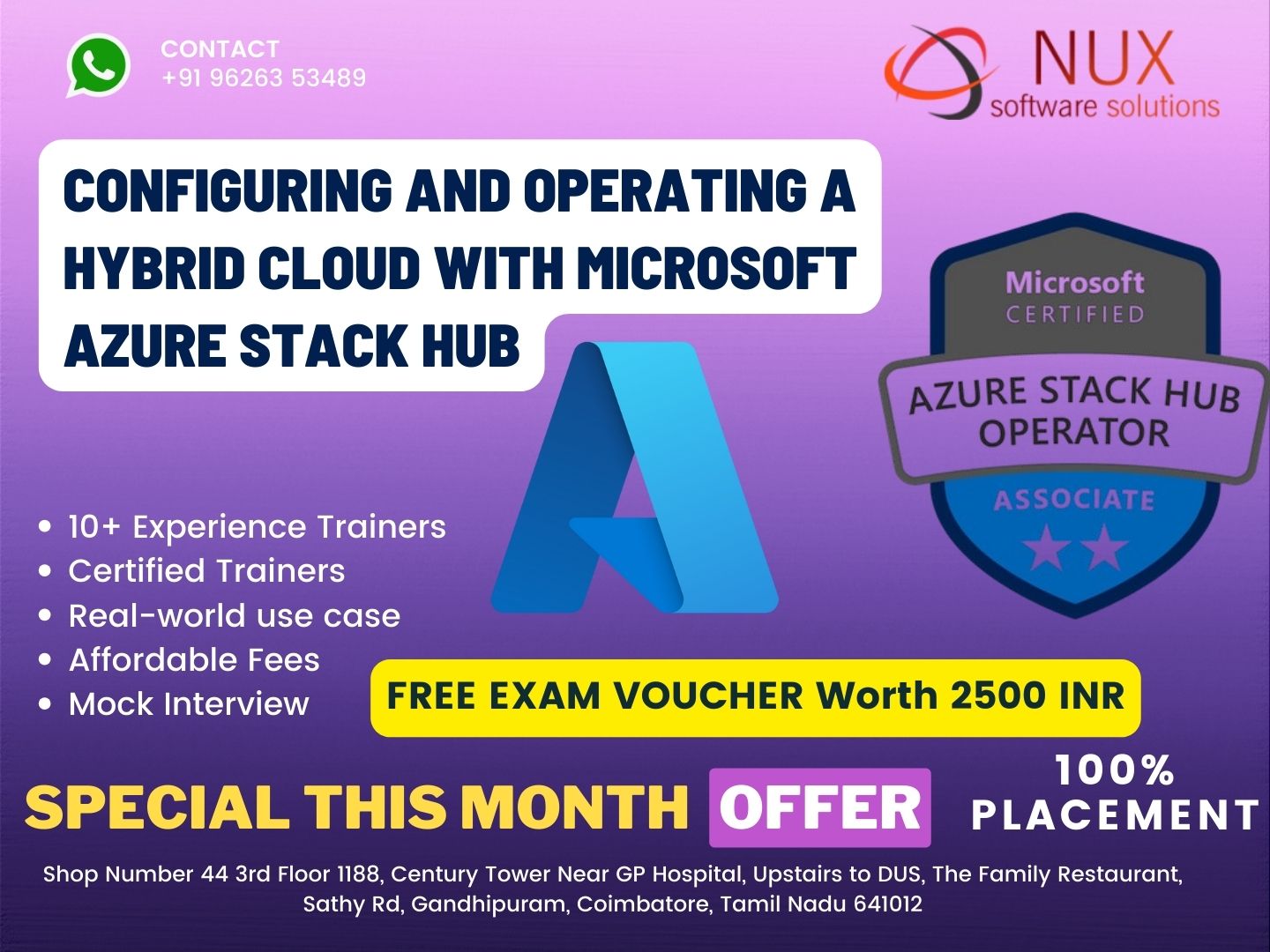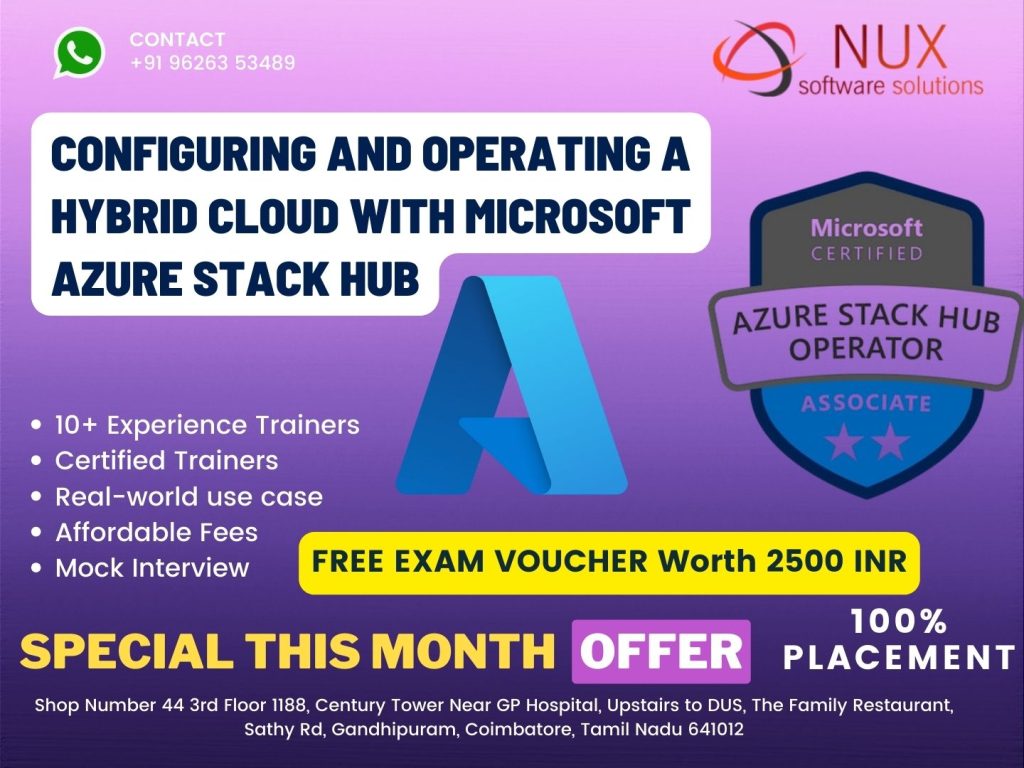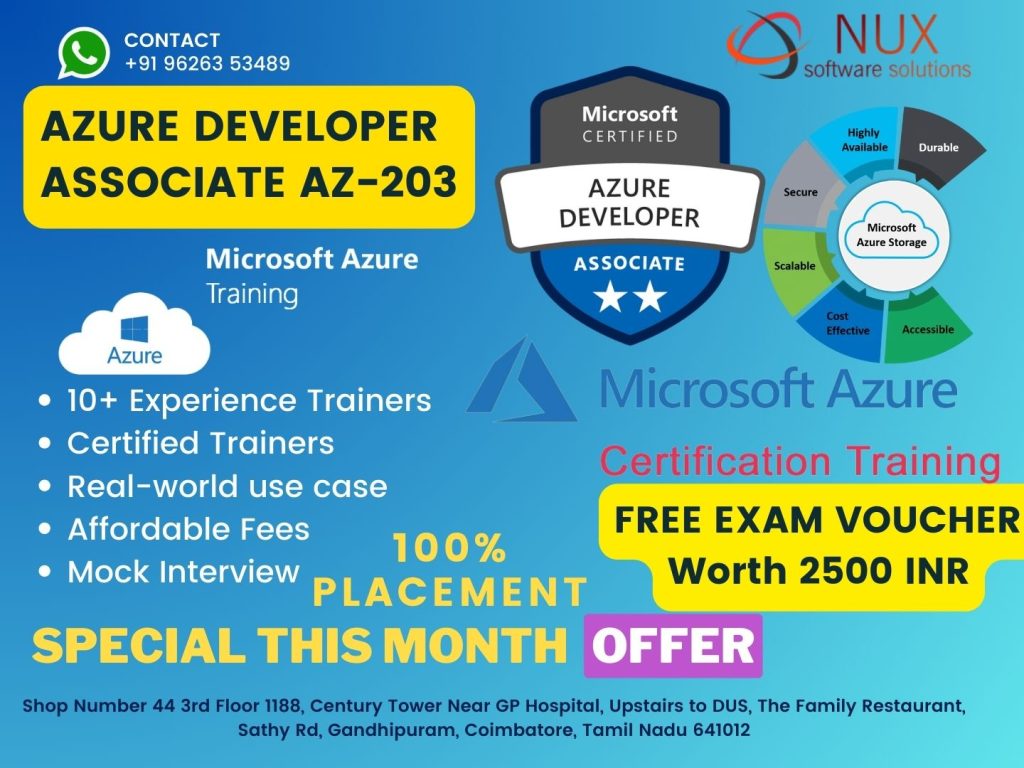Configuring and Operating a Hybrid Cloud with Microsoft Azure Stack Hub – AZ-600

AZ-600: Azure Stack Hub Hybrid Cloud Training in Coimbatore
Course Overview
The AZ-600 certification course, Configuring and Operating a Hybrid Cloud with Microsoft Azure Stack Hub, is designed for IT professionals who want to extend Azure services to on-premises environments using Azure Stack Hub. This training focuses on deploying, managing, and operating hybrid cloud infrastructure by integrating Azure Stack Hub with core Azure services.
At Linux Training Center in Coimbatore, this course offers hands-on, instructor-led training that covers real-world hybrid cloud deployment scenarios with a focus on scalability, consistency, and security.
Why Choose AZ-600?
As organizations embrace hybrid IT models, the ability to run Azure services in private datacenters is becoming essential. Azure Stack Hub enables consistent development and operations across on-premises and cloud environments. The AZ-600 certification validates your expertise in managing Azure Stack Hub and hybrid workloads.
This course is ideal for professionals looking to support hybrid cloud architectures and deliver cloud services locally while maintaining integration with global Azure.
Who Should Enroll?
This course is designed for cloud administrators, system engineers, data center professionals, and Azure architects responsible for managing Azure Stack Hub infrastructure. It’s especially beneficial for those working in environments with connectivity limitations, regulatory compliance requirements, or hybrid deployment needs.
Familiarity with Azure administration, networking, and virtualization is recommended.
What You Will Learn
Deploy and configure Azure Stack Hub infrastructure
Register and connect Azure Stack Hub to Azure
Manage users, subscriptions, and tenants using RBAC and identity providers
Offer services including IaaS and PaaS through Azure Stack Hub
Maintain and monitor system health and performance
Implement backup, recovery, and compliance using Microsoft tools
Manage marketplace items, virtual networks, and storage resources
You will gain practical experience in configuring resource providers, enabling multi-tenancy, and administering a hybrid cloud environment.
Course Highlights
Microsoft-approved syllabus aligned with the AZ-600 certification
Real-time hands-on labs with hybrid cloud setup
Delivered by Microsoft-certified hybrid cloud specialists
Scenario-based learning for real-world hybrid solutions
Weekday and weekend batch options available
Career Opportunities
After completing this course, you’ll be qualified for roles such as Hybrid Cloud Administrator, Azure Stack Hub Specialist, Cloud Solutions Architect, and Infrastructure Consultant. The AZ-600 certification helps you stand out as an expert in hybrid cloud deployments—especially in regulated industries requiring data residency and offline operations.
Why Linux Training Center?
Linux Training Center in Coimbatore is a trusted hub for cloud computing and hybrid infrastructure training. Our expert instructors bring industry knowledge and practical expertise to ensure every student masters the tools, concepts, and architecture needed for successful Azure Stack Hub implementation.
Configuring and Operating a Hybrid Cloud with Microsoft Azure Stack Hub – AZ-600 Syllabus
Modules
Analyze solution requirements (25-30%)
Plan and deploy Azure Stack Hub (30–35%)
Plan an Azure Stack Hub deployment
Recommend a deployment model for a specific scenario
Recommend a name resolution strategy
Define fully qualified domain name (FQDN) and region name
Recommend a public and internal IP strategy
Define static routes or Border Gateway Protocol (BGP) configuration
Recommend a datacenter firewall integration strategy
Choose between Microsoft Entra ID and Active Directory Federation Services (AD FS)
Validate identity provider and network by using the Azure Stack Hub Readiness Checker tool
Select a billing model
Plan and implement infrastructure certificates for Azure Stack Hub
Choose between an Enterprise certificate authority (CA) and a public certificate
Prepare certificates for Azure Stack Hub
Import certificates
Export PFX files
Prepare folder structure
Validate certificates by using the Azure Stack Hub Readiness Checker tool
Rotate secrets for certificates
Manage Azure Stack Hub registration and billing
Recommend a registration model
Register in a connected environment
Register in a disconnected environment
Validate Azure Stack Hub registration
Refresh Azure Stack Hub registration
Set up usage data reporting
View and retrieve usage data by using the usage API
Manage usage and billing in multitenant and cloud solution provider (CSP) scenarios
Set up management environment
Obtain and connect to Azure Resource Manager endpoints
Download and deploy Operator Access Workstation
Install PowerShell modules for Azure Stack Hub
Enable Azure CLI for Azure Stack Hub users
Download and deploy Azure Stack PowerShell tools
Add relevant environment based on a scenario
Enable the Emergency VM Access Service (EVA)
Provide services (20–25%)
Manage Azure Stack Hub Marketplace
Populate Azure Stack Hub Marketplace from a connected environment
Populate Azure Stack Hub Marketplace in a disconnected environment
Create a custom Azure Stack Hub Marketplace item
Manage the lifecycle for Azure Stack Hub Marketplace items
Create an ARM template
Offer the Azure App Service resource provider
Plan the App Service resource provider deployment
Deploy the App Service resource provider
Update the App Service resource provider
Scale roles based on capacity requirements
Rotate App Service secrets and certificates
Manage and monitor worker tiers
Back up App Service resource provider, including SQL databases, file server share, and secrets
Offer the Azure Event Hubs resource provider
Plan an Event Hubs resource provider deployment
Deploy an Event Hubs resource provider
Update an Event Hubs resource provider
Rotate Event Hubs secrets and certificates
Offer services
Create and manage quotas
Create and manage plans
Create and manage offers
Create and manage user subscriptions
Change user subscription owner
Manage infrastructure (40–45%)
Manage identity and access
Assign users and groups in Azure Stack Hub
Grant an app access to resources
Define a custom role in Microsoft Entra ID for delegating Azure Stack Hub management tasks to users
Register a tenant directory with Azure Stack Hub
Update a tenant directory
Unregister a tenant directory
Monitor and maintain system health
Monitor system health by using the administrator portal
Monitor system health by using PowerShell
Monitor system health by using the REST API
Respond to and manage alerts
Validate health and system status by using Test-AzureStack
Monitor Azure Stack Hub infrastructure certificates
Collect diagnostic logs on demand by using the administrator portal
Collect diagnostic logs on demand by using the privileged endpoint
Configure automatic diagnostic log collection
Configure syslog forwarding for Azure Stack Hub infrastructure
Plan and configure business continuity and disaster recovery (BCDR)
Retrieve BitLocker recovery keys
Recommend a BCDR strategy
Recommend a solution for tenant backups
Choose a method for infrastructure backups
Configure storage target for infrastructure backups
Configure certificates for infrastructure backups
Configure frequency and retention policy for infrastructure backups
Test backup and restore of infrastructure by using Azure Stack Development Kit
Enable backup by using PowerShell
Validate success status of backup
Perform node and system-wide operations
Add nodes
Manage storage capacity by reclaiming space or rebalancing
Add IP pools
Stop and start Azure Stack Hub
Perform node operations, including start, stop, resume, repair, drain, and shutdown
Configure Time Server (NTP)
Configure syslog server
Configure DNS server
Update Azure Stack Hub, including scheduling, deploying, monitoring, and troubleshooting
Update Microsoft Entra home directory
Configure and use privileged endpoints
Connect to a privileged endpoint
Configure the cloud admin user role
Unlock a support session
Close the session on the privileged endpoint



